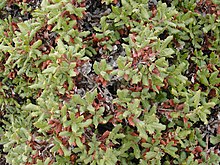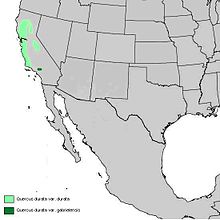-
Leathery texture of leaves
-
Juvenile acorn
-
Mature acorns
-
Shown with Garrya buxifolia
| Leather Oak | |
|---|---|

| |
| var. durata | |
|
Scientific classification
| |
| Kingdom: | Plantae |
| Clade: | Tracheophytes |
| Clade: | Angiosperms |
| Clade: | Eudicots |
| Clade: | Rosids |
| Order: | Fagales |
| Family: | Fagaceae |
| Genus: | Quercus |
| Subgenus: | Quercus subg. Quercus |
| Section: | Quercus sect. Quercus |
| Species: | Q. durata
|
| Binomial name | |
| Quercus durata | |

| |
| Natural range of Quercus durata | |
| Synonyms [2] | |
| |
Quercus durata, commonly known as leather oak, is a species of oak endemic to California, common in the Coast Ranges and the foothills of the Sierra Nevada. The common name "leather oak" is derived from the leathery texture on the lop of its leaves. Taxonomically it is placed in the white oak group (subgenus Quercus, section Quercus).
Description
As described by English horticulturist and botanist Theodore Payne, leather oak is "A rather low spreading shrub with rigid branches, foliage rich deep green. Desirable for hillside planting." [3] Quercus durata is a short species of oak generally growing to 1–2 metres (3+1⁄2–6+1⁄2 feet) in diameter with a height of about 0.5–1.5 m (1+1⁄2–5 ft). In more extreme cases they have been known to grow to be 3–4 m across. The gray or yellowish twigs have scaly bark and are about 1–3 centimetres (1⁄2–1+1⁄4 inches) in diameter with the trunk diameter reaching 4–5 cm; the branches can be densely or sparsely distributed. The buds are smooth brown or reddish brown ovals.
The leaf blades are cupped or convex, rarely somewhat planar; their dimensions are 1.5–3 cm long and 1–1.5 cm broad densely or sparsely distributed along the branches while the margins of the leaves can be entirely or irregularly toothed. [4] The adaxial (upper) surface of the leaves are greenish or yellowish with short semi-erect hairs; the secondary veins are obscure, dense or scattered. The abaxial (lower) surface of the leaves are covered with erect rayed hairs 1–4 millimetres (1⁄16–3⁄16 in) in length that are felty to the touch with prominent secondary veins.
The acorns of the leather oak can be found solitary or paired at the end of a small stalk; the cup which encloses up to half of the nut is reddish or yellowish with a scaly texture. The nut itself is cylindrical, measuring 1.5–2.5 cm in diameter and 1–2.5 cm long, the apex can be rounded or obtuse. [5] [6] Because leather oak is a species of white oak, its acorns mature in about 6 months, are hairless inside the acorn shell, and are sweet or slightly bitter tasting; the shell is mildly toxic. It is a dicot that flowers in the spring, typically April or May. [7]
Var. gabrielensis
The largest differentiation between the morphology of the durata variant and the gabrielensis variant is found in the leaves. The leaves of the gabrielensis variant are not as densely crowded and still commonly have regular teeth along the edges. The upper surfaces are colored a darker green and are glossy, glabrous (without hair) and usually moderately cupped or sub-planar. The lower surface of the leaves have persistently wooly surfaces with hairs 2–4 mm in length. [8] [9]
Habitat and ecology
The range of Quercus durata stretches from Shasta County in Northern California to the bottom of the South Coast Range in Santa Barbara County. The most common variant is found in foothill woodlands and chaparral ecosystems at elevations between 30 and 1,570 m (100 to 5,150 ft). [7] It is especially abundant in Sargent cypress ( Hesperocyparis sargentii) woodlands which can be found in portions of Mendocino, Sonoma, San Mateo, Santa Clara, Monterey, San Benito, San Luis Obispo and Santa Barbara counties as well as the San Francisco Bay region. [4] In more sheltered, inland areas like MacNab cypress ( Hesperocyparis macnabiana) woodlands this shrub can extend into riparian zones where summer fogs persist. [10] Q. durata is well suited for ultramafic soils which are reddish and typically nutrient poor, having abundant nickel, magnesium, and chromium content while lacking calcium. Ultramafic chaparral communities are found below 500 m (1,500 ft) from Santa Barbara County north through the North Coast Ranges and also within the foothills of the Sierra Nevada and portions of the California Central Valley. Here, Q. durata can be found with shrubs including chamise ( Adenostoma fasciculatum), coffeeberry ( Frangula californica), buckthorn ( Rhamnus crocea) and toyon ( Heteromeles arbutifolia). Scattered occurrences of canyon live oak and coast live oak are also found here. In cases outside of serpentine environments, leather oaks typically occur as isolated individuals within a backdrop of plant associations dominated by California scrub oak (Q. berberidifolia) and interior live oak (Q. wislizeni). [4] The climate in Q. durata habitat is characterized by 41 to 170 cm (16 to 67 in) of annual precipitation during a wet season of 3 to 8 months, temperatures range from a December low of 30 °F to a July high of 96 °F. It can sustain life in soil pH between 5.5 and 8.3. [7]
Based on controlled studies done at Jasper Ridge Biological Preserve the harsh environment of Q. durata limits species re-establishment after forest clearing or in colonization of grassland at chaparral-prairie boundaries. Low summer precipitation, high solar insolation, and herbivory are the basis for this difficulty rather than germination rates. [11]
Var. gabrielensis
Occurs at elevation 370–2,290 m (1,215–7,515 ft) as a limited distribution taxon in the San Gabriel Mountains within the San Bernardino and Los Angeles counties. The dry, exposed slopes of the San Gabriels stretching from La Cañada to Pomona are covered in a chaparral with non-serpentine soils suitable for Quercus durata var. gabrielensis. [4] [5] The precipitation, temperature, and soil pH ranges for the gabrielensis variant are much narrower than the common variant sitting at approximately 24-47 in of water annually, 44-51 °F, and 6.4 to 6.9 pH respectively. The December low in this region is 36 °F while the July high can reach 90 °F. [8]
Biotic interactions
When located close to species of pine, Q. durata can be infected by certain species of heteroecious rust fungi ( cronartium). [12] Leather oak is a host for the parasitic Gall Wasp Cynips washingtonensis, who deposits its larvae onto the plant and construct small 1–3 mm spherical galls on Q. durata as well as valley oak (Q. lobata) and coastal sage scrub oak (Q. dumosa). These galls appear in early spring and can be quite numerously attached to twigs and leaves; the gall is typically engulfed in a mass of velvety hairs. Crystalline gall wasp larvae ( Andricus crystallinus) can form irregularly shaped, pallidal galls that agglomerate into masses, with individual galls being between 8–9 mm in length. [13]
It is also a host plant for the sleepy duskywing (Erynnis brizo) butterfly, which sometimes feeds on nectar, and the Pacific tent caterpillar moth (Malacosoma constricta). [14] Birds and small mammals can be attracted to the acorns.
Uses
In a study done by Narvaez et al. in 2000 with a group of goats and sheep at the Hopland Research and Extension Center, it was found that for animals employed in vegetation management programs across grass woodlands and chaparral ecosystems nutritional quality and intake levels of Q. durata and Adenostoma fasciculatum foliage were low and demonstrated a need for diet supplementation in livestock performing as part of vegetation control programs. [15]
Native Americans peoples used leather oak as a source of food and medicine. After leaching tannins from the acorns, they would mash it into a nutritional mush that in tandem with other oak products was a staple in their diets. One prevalent leaching method was to place raw acorns in a cloth pouch and leave it in a stream for several weeks to break down. In modern times the mulch from the leather oak is applied to gardens for its efficacy in repelling slugs and grubs. After pupation the oak's gall extracts can be used in tannins and dyes. [16]
Bibliography
- C. Michael Hogan, California Arts and Sciences Institute, https://casicalifornia.org (2014, updated 2023). Leather Oak. Encyclopedia of Earth. National Council for Science and Environment, Washington DC. Retrieved from http://editors.eol.org/eoearth/wiki/Leather_Oak
- Los Padres Forestwatch (2023) Oaks of the Los Padres National Forest. https://lpfw.org/our-region/wildlife/oaks/
References
- ^ Kua, C.-S. (2020). "Quercus durata". IUCN Red List of Threatened Species. 2020: e.T86583109A183115411. doi: 10.2305/IUCN.UK.2020-3.RLTS.T86583109A183115411.en. Retrieved 20 November 2021.
- ^ "Quercus durata Jeps.". World Checklist of Selected Plant Families. Royal Botanic Gardens, Kew – via The Plant List. Note that this website has been superseded by World Flora Online
- ^ Theodore Payne (firm; 1941). California native plants, trees, shrubs, perennials, p. 29.
- ^ a b c d "Leather Oak". archive.md. 2012-05-29. Archived from the original on 2012-05-29. Retrieved 2021-11-07.
- ^ a b "Quercus durata in Flora of North America @ efloras.org". www.efloras.org. Retrieved 2021-11-05.
- ^ "Quercus durata var. durata in Flora of North America @ efloras.org". www.efloras.org. Retrieved 2021-11-05.
- ^ a b c "Quercus durata var. durata Calflora". www.calflora.org. Retrieved 2021-11-11.
- ^ a b "Quercus durata var. gabrielensis Calflora". www.calflora.org. Retrieved 2021-11-11.
- ^ "Quercus durata var. gabrielensis in Flora of North America @ efloras.org". www.efloras.org. Retrieved 2021-11-11.
- ^ Michael., Barbour (2007). Terrestrial Vegetation of California, 3rd Edition. University of California Press. OCLC 939770158.
-
^ Staffan., Williams, Kimberlyn. Davis, Stephen D. Gartner, Barbara L. Karlsson.
Factors limiting the establishment of a chaparral oak, Quercus durata Jeps, in grassland.
OCLC
1230177673.
{{ cite book}}: CS1 maint: multiple names: authors list ( link) - ^ Phytopathology. Vol. 6. American Phytopathological Society. 1916. p. 229.
- ^ Ron., Russo (2007). Field guide to plant galls of California and other western states. Univ. of California Press. ISBN 978-0-520-24885-4. OCLC 615336234.
- ^ Boisduval, Jean Alphonse (1833). Histoire générale et iconographie des lépidoptères et des chenilles de l'Amerique septentrionale par le docteur Boisduval et J. Leconte. Paris: Roret. doi: 10.5962/bhl.title.9470.
- ^ Narvaez, Nelmy; Brosh, Arieh; Mellado, Miguel; Pittroff, Wolfgang (2011-04-08). "Potential contribution of Quercus durata and Adenostoma fasciculatum supplemented with Medicago sativa on intake and digestibility in sheep and goats". Agroforestry Systems. 83 (3): 279–286. doi: 10.1007/s10457-011-9387-2. ISSN 0167-4366. S2CID 20601081.
- ^ Grieve, Maud (1980). A modern herbal : the medicinal, culinary, cosmetic and economic properties, cultivation and folklore of herbs, grasses, fungi, shrubs and trees with all their modern scientific uses. C. F., Mrs Leyel. Harmondsworth: Penguin. ISBN 0-14-046440-9. OCLC 16477079.
External links
- Jepson Manual treatment
- Quercus durata in the CalPhotos photo database, University of California, Berkeley
- IUCN Red List least concern species
- Quercus
- Endemic flora of California
- Natural history of the California chaparral and woodlands
- Natural history of the California Coast Ranges
- Natural history of the San Francisco Bay Area
- Natural history of the Transverse Ranges
- Plants described in 1909
- Taxa named by Willis Linn Jepson
- Medicinal plants of North America
- Garden plants of North America
- Drought-tolerant plants




